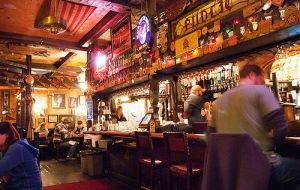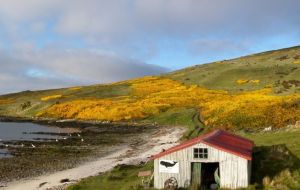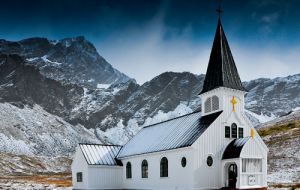MercoPress. South Atlantic News Agency
Vogue exploring the Falklands: Island hopping at the end of the world
 Attempt a pub crawl around the English pubs in Stanley, pausing in iconic red phone booths for pics along the way. Start at the wood-panel-lined Victory Bar
Attempt a pub crawl around the English pubs in Stanley, pausing in iconic red phone booths for pics along the way. Start at the wood-panel-lined Victory Bar  Carcass Island, roughly a seven-square-mile island, is one of the archipelago’s most visited (and a photographer favorite), with main residents the sea-based mammals
Carcass Island, roughly a seven-square-mile island, is one of the archipelago’s most visited (and a photographer favorite), with main residents the sea-based mammals  Grytviken in South Georgia was the Antarctic’s first whaling station, and resting place for famous explorer Ernest Shackleton, and lies 800 miles SE of the Falklands
Grytviken in South Georgia was the Antarctic’s first whaling station, and resting place for famous explorer Ernest Shackleton, and lies 800 miles SE of the Falklands Vogue magazine in its Living section, dedicated a well illustrated piece to the Falklands and to South Georgia, underlining its untouched beauty. Written by Lane Nieset, it offers five travel options, four in the Falklands and one in South Georgia.
The Antarctic Peninsula lies roughly 621 miles away from Ushuaia, the Argentine resort town nicknamed the “End of the World.” Cruising from here through some of the world’s roughest seas, through passages glowing with geometric-shaped icebergs, to the southernmost continent known to be the coldest and windiest on Earth holds enough appeal, but the untouched islands along the way are just as wild. Hopscotch from South America to the Falkland Islands around 300 miles east of the Patagonian coast, camping on deserted coastlines and hiking past penguin colonies nesting on mountain ranges 2,300 feet high.
From this archipelago, sail farther south to a spot that’s even trickier to reach—the uninhabited island of South Georgia. At this seemingly broken-off piece of the Andes, the only greeting you’ll receive as you kayak around the shore is from fur seals and king penguins.
From the Falklands to South Georgia, here are five remote islands to see—with details on how to reach them—en route to the final port of call, Antarctica.
How to get there: The easiest way to reach the Falkland Islands is by flying in to Mount Pleasant Complex’s airport, sitting outside of capital city Stanley. LATAM Airlines flies on Saturdays once a week from Santiago, Chile. You can also reach the Falkland Islands by sea, cruising on expedition voyages with liners like Hurtigruten, Seabourn, and Silversea Cruises.
Once you arrive, island hop reportedly like the locals on daily flights with the Falkland Islands Government Air Service (FIGAS), which flies to 29 locales across the archipelago. Reaching South Georgia, meanwhile, is a bit more of a mission since it doesn’t sport an airstrip. The most common route is with a cruise ship, but those going for more of an expedition edge can charter a sailing yacht with operators like Golden Fleece Expedition Cruises.
1. East Falkland, Falkland Islands
The jewel box–color homes huddled around Stanley house most of the capital city’s population of roughly 2,500. One of the best ways to get a lay of the land, which has been called more “British than Britain,” is with a pub crawl around the English pubs in town, pausing in iconic red phone booths for pics along the way. Start at the wood-panel-lined Victory Bar, clad in Union Jack flags and Elvis Presley memorabilia. Be sure to sip the local brew on tap, Falkland Beerworks’s Rock Hopper Natural Blonde, served alongside “Falkland-famous” fish and chips.
After fueling up, hop in a 4×4 for the 45-minute off-road ride to the penguin colony at Bluff Cove Lagoon, popping in for afternoon tea and home-baked scones at the farm’s Sea Cabbage Café. Don’t leave without sampling the handcrafted diddle-dee jam, blended from the bittersweet berries grown in the lagoon’s surrounding bushes.
2. Carcass Island, Falkland Islands
As you cruise in to Port Patterson on the southern edge of Carcass Island, don’t be too surprised if your first greeting comes from fur seals eager to hop up on dock. The coast is strewn with eggshell-white sandy beaches, with turquoise waves almost identical in color to the Caribbean, except for the sea lions swimming off shore.
While the roughly seven-square-mile island is one of the archipelago’s most visited (and a photographer favorite), the main residents here are the sea-based mammals. A couple lives year-round on Carcass Island managing its only accommodation, a converted farmhouse surrounded by mustard yellow gorse wildflowers. The stay here is worth it, though, for the homemade cuisine alone, whipped up from organic vegetables and meats sourced around the island. If you’re on an expedition cruise with liners like Hurtigruten, you can even sleep under the stars while camping nearby along the shore. You’ll have the island practically to yourself, so get your bearings by hiking to one of the highest points, Stanley Hill, for views across Byron Sound and West Falkland.
3. West Point Island, Falkland Islands
The draw to this working sheep farm on the northwest corner of West Falkland is Devil’s Nose—a rocky stretch sweeping out over the sea. From the harbor, it’s just a hike to the jagged cliffs housing thousands of black-browed albatross and red-eyed rockhopper penguins.
The only ways to reach the island are via boat from Carcass, which is also where most travelers stay since West Point doesn’t offer any lodging, or as part of a cruise stop. You will find one settlement on shore, though. Fifth-generation Falkland Islanders Allan and Jacqui manage one of the oldest continuously lived-in farmhouses in the archipelago, which dates back to the mid-1800s. While their favorite part about living on the island is the “constant peace and quiet,” the couple are known for carrying on the original owners’ tradition of welcoming travelers inside for a warm cup of tea and freshly baked cakes.
3. Saunders Island, Falkland Islands
Set off from Port Egmont on a two-hour hike of the first British settlement in the Falkland Islands, still scattered with remains of the original buildings dating back to 1765. Along the way, make the climb up Mt. Richards, taking in views over Saunders and neighboring Keppel Island. Five species of penguins sit on the island’s three peninsulas, but if you want to sleep within walking distance of most of the wildlife, stay near The Neck. Don’t expect five-star standards, though. The theme here is all about sleeping as close to nature as possible. You have two options when it comes to overnight: camping on the sandy isthmus or staying in a two-room lodge, a former military Portakabin.
4. South Georgia
The port of Grytviken was the Antarctic’s first whaling station—and resting place for famous explorer Ernest Shackleton—but the crescent-shaped island 800 miles southeast of the Falklands gets much more interesting once you leave the shore. The miles-long hike from Grytviken to the apparent former smuggler’s cover of Majviken feels like you’re trekking through all four seasons, stepping from grass and mud to foot-deep snow. But the views alone make it all worthwhile as you look out at the fur seals nursing on shore and over to the island’s highest peak, the 9,629-foot-tall Mt. Paget, visible only on the clearest of days.




Top Comments
Disclaimer & comment rules-

-

-

Read all commentsMarti Llazo
Jan 21st, 2017 - 08:32 pm +1very good..
Think
My name is Isolde
I think Isolde will be visiting very soon.
Vogue exploring the Falklands
Jan 21st, 2017 - 12:42 pm 0??
And why not, did not Vogue explore Theresa may.
and that a success was it not .lol
@B “did not Vogue explore Theresa may.”
Jan 21st, 2017 - 01:43 pm 0I get a Hard Brexit just thinking about it.
Commenting for this story is now closed.
If you have a Facebook account, become a fan and comment on our Facebook Page!